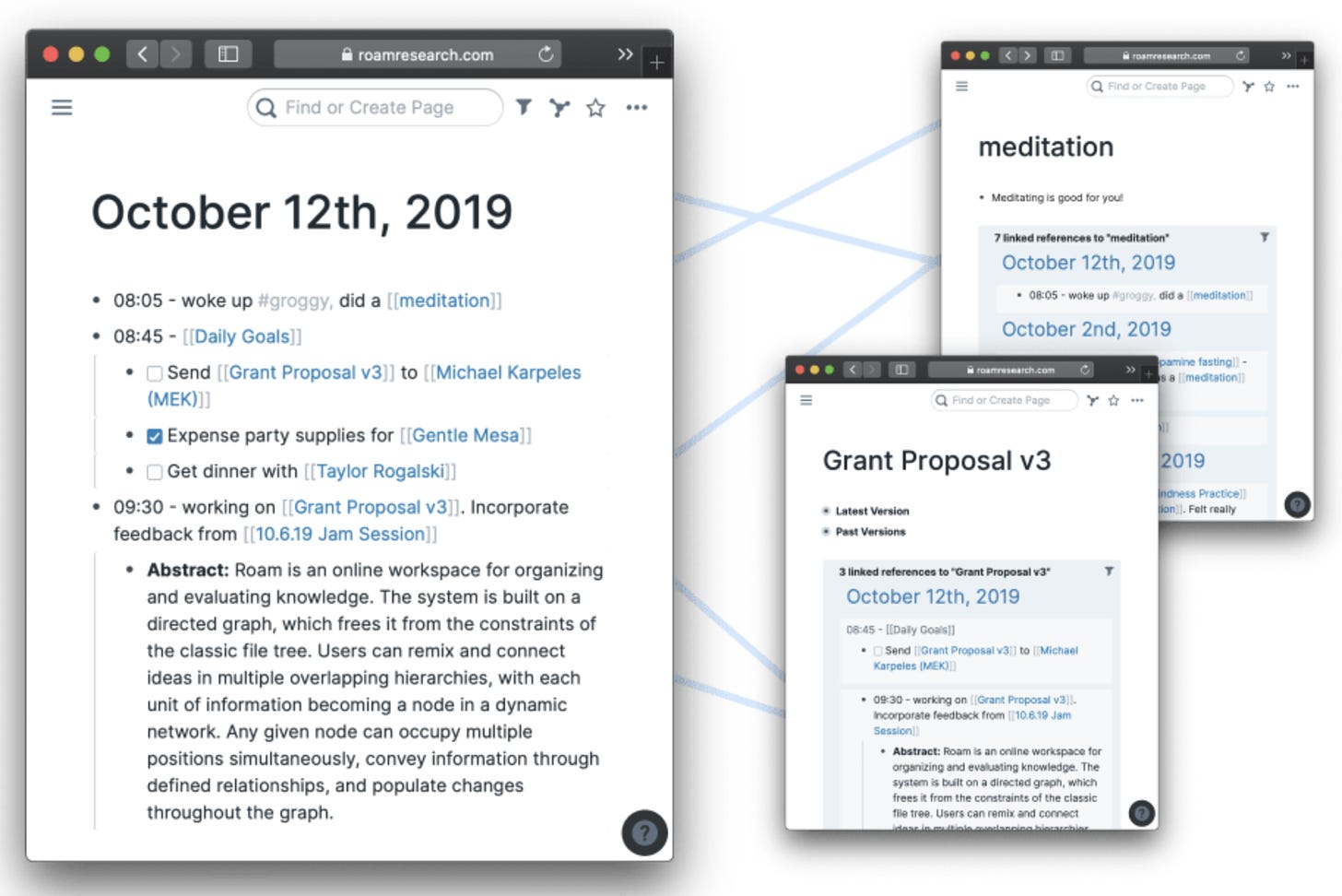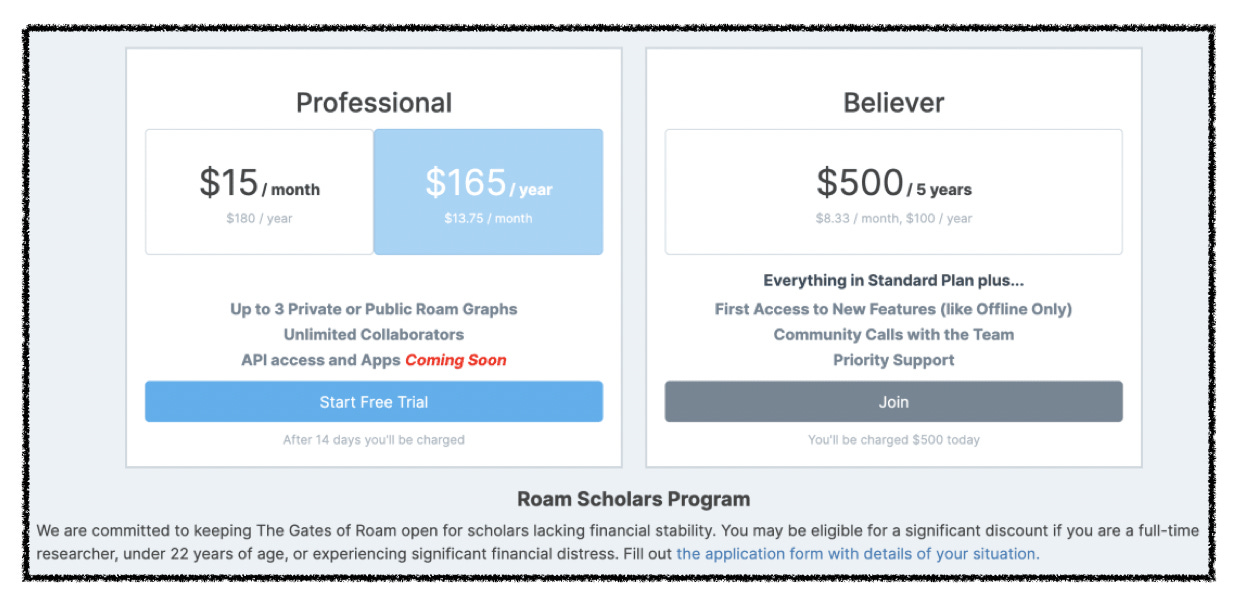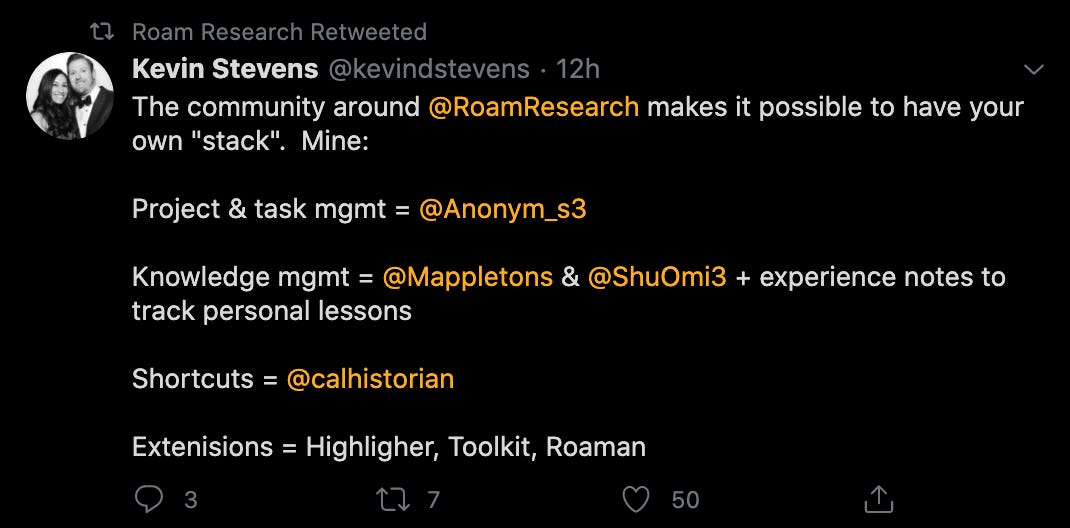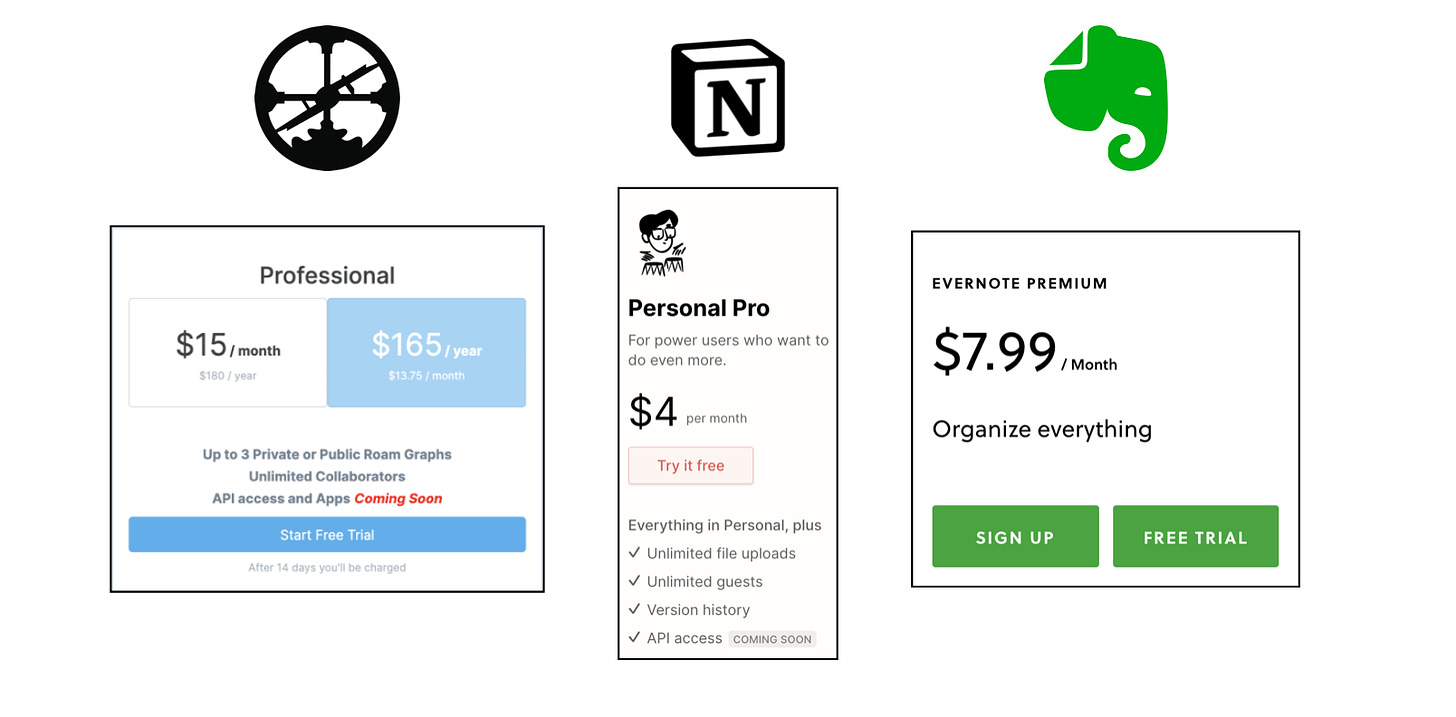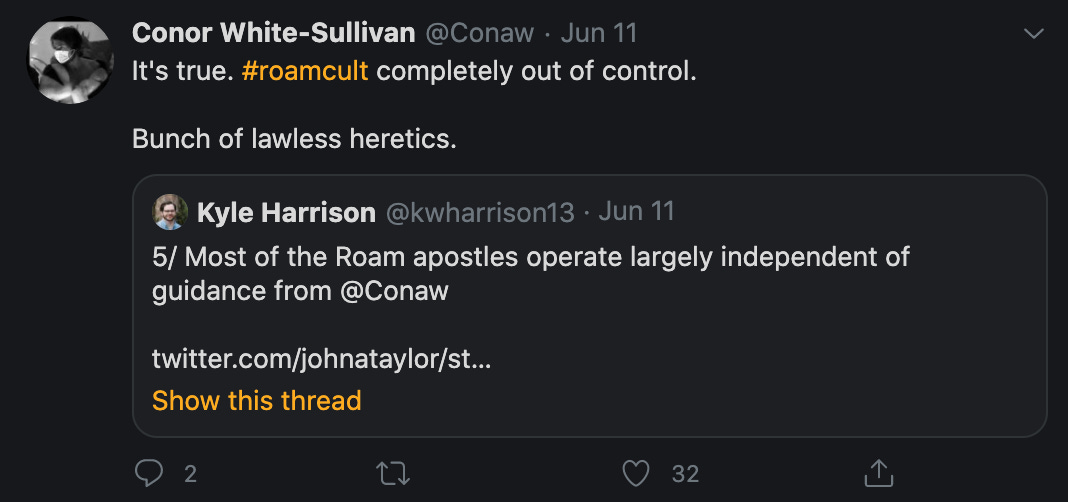SaaS Pricing is hard. PricingSaaS is your cheat code.
Monitor competitors, track real-time benchmarks, discover new strategies, and more.
I imagine most people reading this fall into one of four buckets…
Bucket 1: Never heard of Roam Research
Bucket 2: Vaguely familiar with Roam Research
Bucket 3: Have tried Roam Research and didn’t get it
Bucket 4: Have tried Roam Research and believe it unlocks higher consciousness
For the unfamiliar, Roam Research is a note-taking application built to replicate the way our brains connect thoughts.
It’s built on the idea of bi-directional linking, and users tend to either get it or they don’t, but the ones that do…really do.
Just look at these testimonials:
“As profound a mental prosthetic as hypertext…”
“Feels like I’m playing learning: the video game…”
“Enabled me to stop segmenting and limiting thoughts…”
High praise, right?!
If you think these statements are excessive, try searching #roamcult on Twitter. I promise you, this is just the tip of the iceberg.
The word culty gets thrown around a lot in tech, and before diving into Roam’s packaging, I want to go down a quick rabbit hole on why I believe Roam actually deserves the label.
Want fresh packaging case studies delivered directly to your inbox? 📩
What it Means to be Culty
On first look, it may seem like Roam has a lot in common with another software company that’s been given the culty label, Superhuman.
While Roam and Superhuman are both opinionated software, driven by keyboard shortcuts, and priced at a premium to competitors, there’s a big difference between the two, which I think can be described by looking at a parallel in fitness.
Superhuman took the traditional email experience and elevated it - optimizing for speed, improving the design, and adding advanced features like spell-check, undo, and AI-enabled triage. This reminds me of Equinox elevating the traditional gym experience with elite equipment, spa treatments, and of course: eucalyptus towels.
While Superhuman and Equinox both have devoted customers, neither has an organic community that’s oriented around an underlying mission. To be truly culty, a company has to exist in service of something deeper than luxury.
As you scroll through tweets tagged with #roamcult, you get the sense these users identify with Roam beyond just using the app, and consider #roamcult a defining trait of their digital lifestyle.
In this sense, Roam is like CrossFit. Both are built on an underlying philosophy. Roam is built on the power of networked thought, CrossFit on a functional approach to fitness.
While CrossFit membership can carry a similar monthly cost to Equinox, it is decisively not luxury. Most CrossFit boxes don’t even have mirrors! CrossFit members pay a high monthly rate because they believe in a specific approach to fitness.
With the release of their first packaging lineup, a similar dynamic now applies to Roam. To use Roam, you have to commit, and this sense of commitment permeates their entire packaging strategy.
The Cult Packaging Playbook
So what does culty packaging look like?
Specifically, Roam is offering two paid plans and a 14-day free trial. Each of these offers is perfectly aligned with developing a cultish user-base. Let’s start with the free trial.
Remember Notion’s new freemium play geared to capture market share? Yeah, that is not what Roam is doing. The free trial tells us two things…
First, Roam isn't interested in a big free user-base right now. Part of this is due to capacity constraints. A little while back, Roam users had issues with data disappearing. Roam’s CEO, Conor White-Sullivan has mentioned their unexpected growth led to these scaling problems, which prompted them to implement a waitlist. Charging for Roam is how they will liberate folks from that waitlist. This leads to the next point...
Roam has no patience for tire-kickers right now. They’re only giving you 14-days to determine if Roam is right for you. This is wild, considering how little Roam offers in terms of onboarding resources.
While they do have a series of welcome videos, they’re brief and basic, meaning the best way to learn how to use Roam is to dive headfirst into the community. New users can follow #roamcult on Twitter, join the RoamResearch Slack, or sign up for courses with power-users like Nat Eliason and Shu Omi.
There are even specialists users can follow for different use-cases:
Clearly, this approach is not for everyone. Just look at the ire it can draw from the uninitiated...
With the trial, you have 14 days to dive-in head-first or keep it moving.
If you do choose to dive in, you have a choice between two paid packages: Professional and Believer.
The Professional plan offers all the core functionality of Roam and is notably more expensive than other note-taking apps. At $15 per month, it’s ~4x the price of Notion’s Personal Pro plan and ~2x the price of Evernote’s Premium plan.
This immediately screens out all potential users that consider cost an important factor in deciding which app to use for knowledge management. Roam is clearly seeking obsessive users over market-share.
As if that wasn’t enough, there’s the Believer plan, which brings the cult ethos to another level.
Usually, there are two main ways to differentiate packages, consumption (usage), and capabilities (features). Roam doesn’t use either! Instead, they differentiate the Believer plan with something that makes sense when you consider their cultish user-base: proximity.
Look at the key differentiators:
Time Commitment (5 years)
First Access to New Features
Community Calls with the Team
Priority Support
For their long-term commitment to the Roam team, Believers get to join the #roamcult inner-circle.
They get first look at new features and can provide input to the product roadmap. They get access to Conor, the Roam team, and the rest of the Believers, and they get product support before anyone else.
Roam is a small team of engineers and their power-users act as an outsourced marketing and community function. In this sense, formalizing the role of Believers is symbiotic. Roam’s power-users want proximity to the team and product, and Roam wants dedicated power-users that will spread the gospel and advance the community - even if they operate autonomously...
Beyond naming the upgraded tier the Believer plan, Roam’s pricing page is peppered with copy furthering their cult positioning. They reference the “Gates of Roam” and refer to Roam users as scholars. Honestly, it’s delightful. The end result is a packaging model that perfectly matches their distinct personality.
In Notion’s New Freemium Play, I referenced a tweet of White-Sullivan’s embracing Roam’s culty vibes. It’s clear from their first packaging model that he’s doubling down.
The question is, will this packaging strategy work?
Building for the Long-Term
So far, it seems that the answer to that question is a resounding yes. Shortly after launching the paid plans, White-Sullivan tweeted this:
Even this tweet is culty! “Citizens of Roam” - I’m all here for it! 🤣
Whether this packaging strategy “works” or not really depends on how you evaluate success. White-Sullivan and the Roam team are clearly trading market share for user engagement. While their acquisition volume might be lower than some competitors and other hot software companies, their retention numbers will flourish.
In the midst of the recent hype-train around Roam, White-Sullivan published a note expressing how he thinks about the company and the current moment:
“…at least a 50 year project…”
“…life’s work…”
“…believe in our vision…”
If this isn’t culty, I don’t know what is!
These guys are building for the long haul at their own pace, and this packaging model will help them grow a community of power-users eager to build with them.
Enjoying Good Better Best?
If you enjoyed this post, I’d love it if you hit the “like” button, that way I’ll know which posts are resonating the most!
If you have thoughts or feedback, I’d love to hear from you! You can find me on Twitter here.




